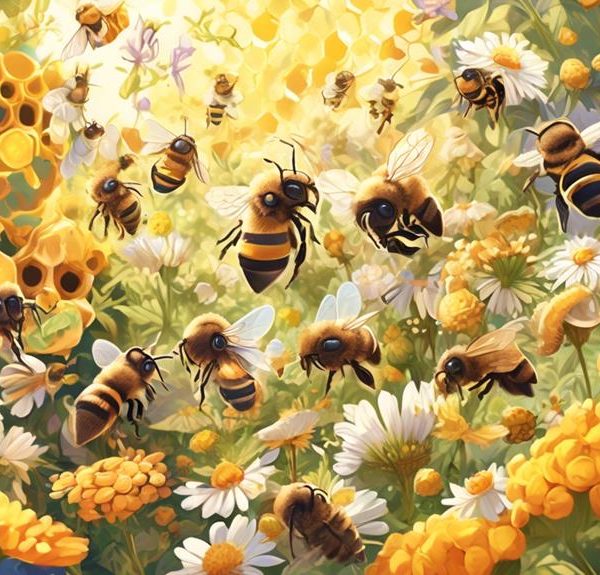Uncover the mystery of whether bees can see yellow, a question with implications reaching beyond our understanding of these fascinating creatures.
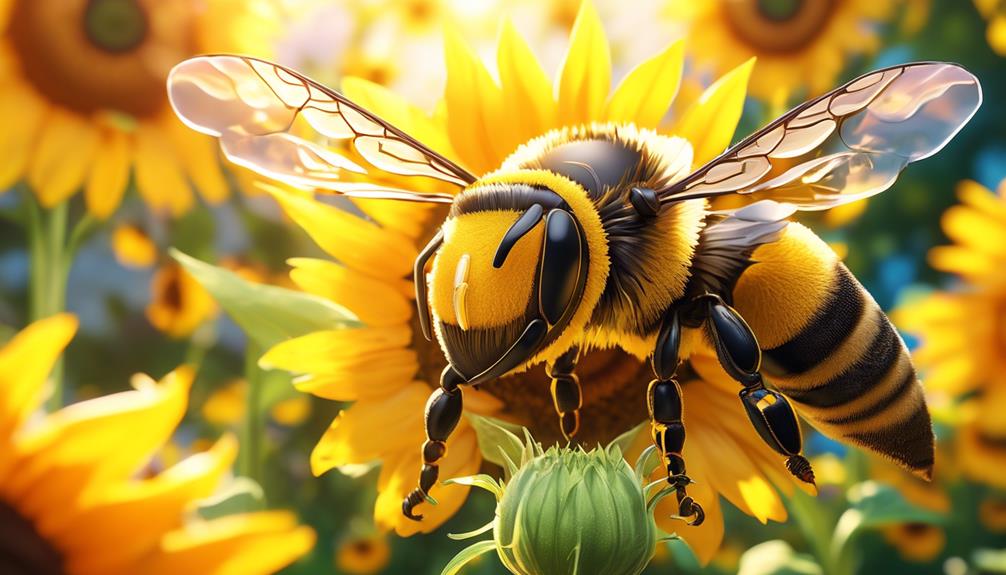
Can Bees See Yellow?
You've probably never lost a night's sleep pondering whether bees can see the color yellow, but it's high time you did. This seemingly trivial question holds significance in fields as diverse as agricultural science, environmental conservation, and even robotics.
Bees, you see, don't perceive the world as we do. Their vision, fine-tuned by millions of years of evolution, is uniquely adapted to their needs. However, whether they can discern the color of sunflowers and ripe lemons remains a point of debate.
You'll want to stick around for this, as the implications of the answer might just change how you see these industrious little insects.
Key Takeaways
- Bees have a trichromatic visual system and can perceive blue, green, and ultraviolet light.
- Bees see yellow as a composite color derived from green and blue.
- Bees' ability to see ultraviolet light helps them detect patterns on flowers, including yellow flowers.
- Bees' attraction to yellow can be utilized in conservation efforts to boost bee populations and promote sustainable food supply for bees.
Understanding Bee Vision

To fully appreciate whether bees can see yellow, it's crucial to delve into the intricacies of bee vision, a sensory system remarkably different from our own. Unlike humans who primarily perceive three basic colors—red, blue, and green—bees operate on a trichromatic visual system as well, but their spectrum is shifted. Bees perceive blue, green, and ultraviolet light, a color invisible to us.
You might wonder how this unique vision affects their perception of yellow. Despite not detecting red, bees can still see yellow, as it's a composite color derived from the green and blue spectrum that they can see. Their ability to see ultraviolet light also plays a significant role in detecting patterns on flowers that aren't visible to the human eye, leading them directly to their nectar.
Their vision is adapted to their lifestyle and environment, designed for efficient foraging. Bees' photoreceptor cells are fine-tuned to the wavelengths of light reflected by flowers, enabling them to locate and recognize different blossoms effectively. This highlights how bee vision, though different from ours, is perfectly tailored to their needs.
The Color Spectrum for Bees
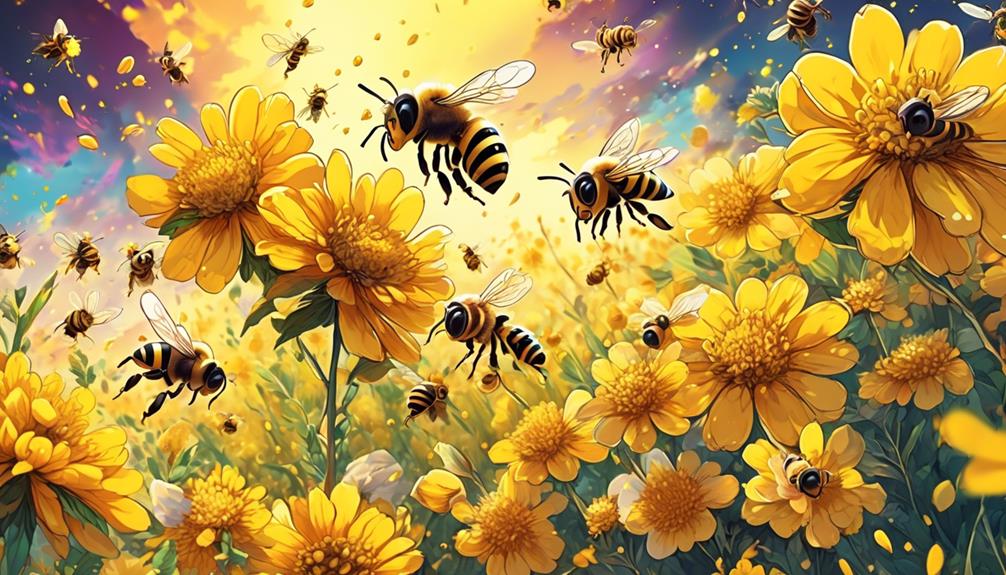
Delving into the color spectrum for bees, you'll find it's a fascinating blend of blue, green, and ultraviolet light, vastly different from the human perception of color. Unlike humans, bees can't see red light. However, they can perceive light in the ultraviolet spectrum which is invisible to us.
Bees' vision is primarily adapted for their ecological needs, particularly for finding nectar. The bee's color perception is tuned to the colors of flowers, which largely reflect in the blue and ultraviolet part of the spectrum. This adaptation gives bees an exceptional ability to distinguish minor changes in flower colors and patterns.
To understand this better, consider the bee's eyes. Their compound eyes are made up of thousands of individual photoreceptor units, or ommatidia. Each ommatidium contributes to a bee's ability to detect subtle changes in color, light intensity, and polarized light, which is particularly useful for navigation.
Bees and Yellow Flowers
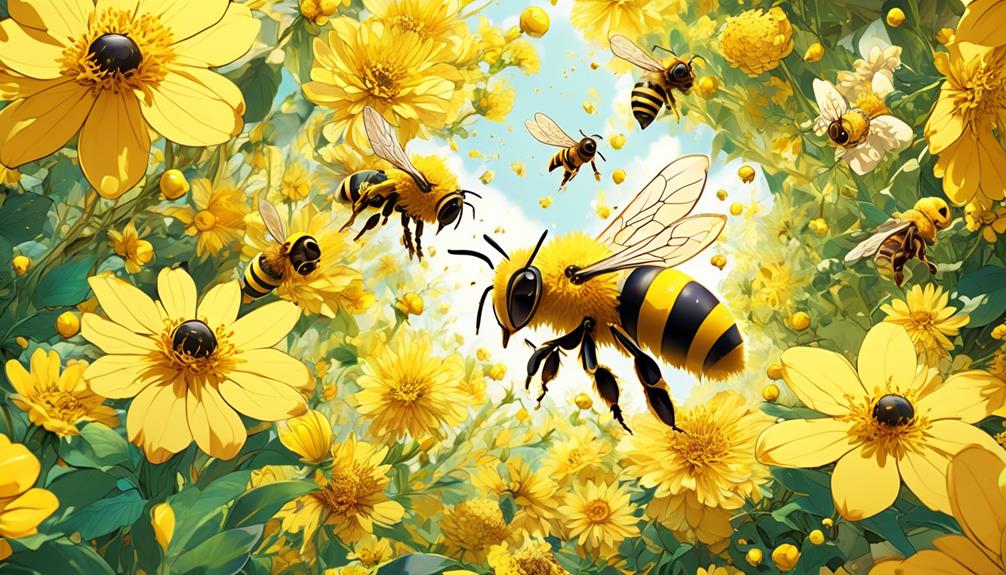
Given their unique visual abilities, you might wonder how bees interact with yellow flowers, a common sight in many gardens and fields. Firstly, it's important to understand that bees don't see the world as we do. Their color spectrum includes ultraviolet light, which humans can't perceive. This changes the way they see yellow.
When a bee approaches a yellow flower, they're not just seeing 'yellow' as we recognize it. They're seeing a combination of green and ultraviolet light. This creates a specific pattern that's highly attractive to bees. It's like a visual beacon, guiding them directly to the flower's nectar and pollen.
Moreover, many yellow flowers have ultraviolet patterns, known as nectar guides, which are invisible to human eyes. These guides lead bees straight to the flower's resources, making their job easier and more efficient. So, yellow flowers aren't just aesthetically pleasing; they're also functional, effectively advertising their rewards to passing bees.
In essence, bees and yellow flowers have a symbiotic relationship. The flowers provide bees with vital nutrients, and in return, the bees pollinate the flowers, ensuring their survival. It's a marvelous example of nature's mutualism, where two species benefit from each other's existence.
Research on Bee's Perception of Yellow
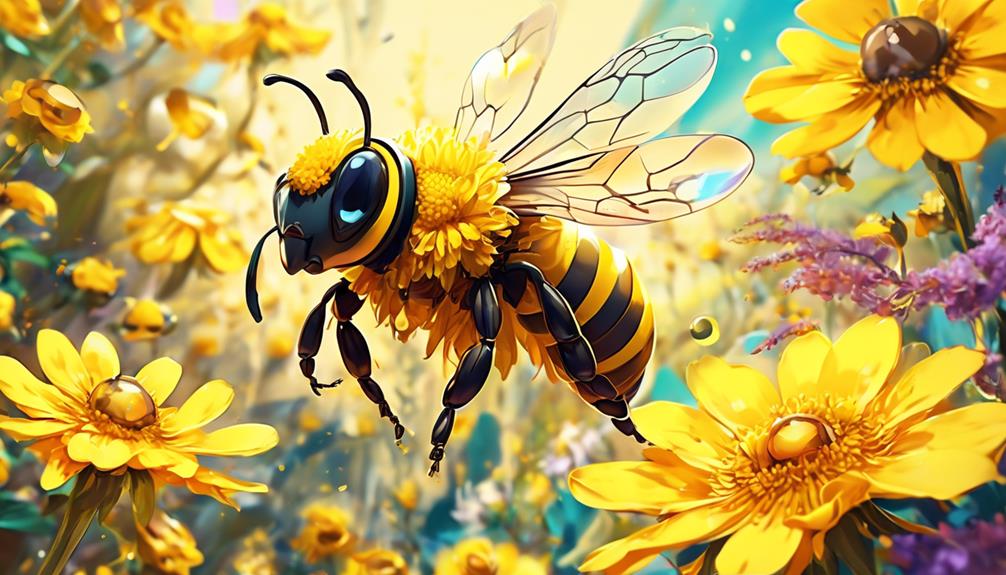
How do scientists uncover the secrets of a bee's perception of yellow, you might wonder? They conduct extensive research using various techniques, primarily behavioral studies and electrophysiological techniques.
Behavioral studies involve observing bees' interactions with different colors. For instance, scientists might observe if bees prefer yellow flowers over other colors or how quickly they locate a yellow object among other colors.
Electrophysiological techniques, on the other hand, involve measuring the electrical activity in a bee's photoreceptor cells when exposed to different colors. This provides direct evidence of bees' color perception.
To help you understand this better, here's a table summarizing the main methods and findings:
Research Method | Process | Findings |
|---|---|---|
Behavioral studies | Observing bees' interactions with different colors | Bees show a preference for yellow |
Electrophysiological techniques | Measuring electrical activity in photoreceptor cells | Bees can perceive yellow |
These studies have shown that bees indeed can see yellow, and they are even attracted to it. This is vital knowledge as it helps us understand why bees are drawn to yellow flowers, contributing to plant pollination.
Implications for Bee Conservation

Understanding that bees can see and are attracted to yellow carries significant implications for their conservation efforts. As you know, bees play a key role in pollination, a critical process for the survival of many plant species. If we can strategically use the color yellow in conservation initiatives, we might be able to enhance bee populations.
Consider this: if you're a conservationist seeking to boost local bee populations, you'd do well to focus on planting yellow flowers or using yellow markers around bee-friendly zones. This isn't just conjecture; it's backed by scientific studies demonstrating bees' proclivity for yellow. They're not just seeing this color; they're actively attracted to it.
This knowledge also helps us re-evaluate the effects of environmental changes on bees. For example, climate change may alter flower blooming patterns, potentially reducing the availability of yellow flowers at certain times. With this understanding, you can develop strategies that ensure a sustainable food supply for bees throughout the year.
In essence, understanding bees' color perception isn't just scientific trivia. It's a potentially powerful tool in our quest to conserve these vital pollinators.
Frequently Asked Questions
What Other Colors Are Bees Attracted to Besides Yellow?"
You're asking about the colors that attract bees besides yellow. Well, bees aren't just attracted to yellow. They're also drawn to colors like blue and violet, since their vision spectrum includes ultraviolet light.
In fact, many bee-pollinated flowers have ultraviolet patterns, invisible to us but brilliantly visible to bees. Remember, bees don't perceive color in the same way we do, they see a different spectrum of light.
How Does the Weather or Season Affect a Bee's Ability to See Yellow?"
Weather and seasons don't directly affect a bee's ability to see yellow. However, they can impact bee activity. In colder weather or winter, bees aren't as active, so they're less likely to be out searching for flowers. Similarly, in rainy conditions, bees may stay in their hives.
Are There Certain Species of Bees That Are More Attracted to Yellow Than Others?"
Yes, certain species of bees are more attracted to yellow than others. For example, honeybees and bumblebees show a strong preference for yellow flowers. This is likely due to their ability to see ultraviolet light, which makes yellow flowers extremely vibrant.
However, not all bees are attracted to yellow. Some species, like the blue orchard bee, are more attracted to blue or purple flowers. Therefore, bee attraction to color can vary by species.
How Does a Bee's Vision of Yellow Compare to Other Insects?"
You're interested in how bees perceive the color yellow compared to other insects.
Bees can indeed see yellow, and in fact, it's one of their favored colors. They're not just seeing the same yellow we do, they're seeing a mix of UV light and yellow.
This unique vision helps them find flowers for pollination.
Comparatively, other insects may not have this same visual capacity, making bees quite special in their color perception.
Do Bees Have a Preference for Certain Shades of Yellow?"
You're curious if bees prefer certain shades of yellow. Indeed, bees are more attracted to brighter, purer yellows. They see color differently from us due to their trichromatic vision, which is more sensitive to the blue and ultraviolet spectrum.
However, it doesn't mean they can't distinguish between shades of yellow. They'll likely navigate towards the shade that stands out the most in their environment.
Conclusion
So, can bees see yellow? Absolutely, they can. They perceive it as a distinct hue within their color spectrum, drawn to its vibrancy in flowers. Research confirms their particular sensitivity to yellow, aiding their foraging habits.
Understanding this not only unlocks secrets of bee vision but also holds implications for their conservation. We've just scratched the surface of the complex world of bees.
Let's keep exploring it, for their sake and ours.


